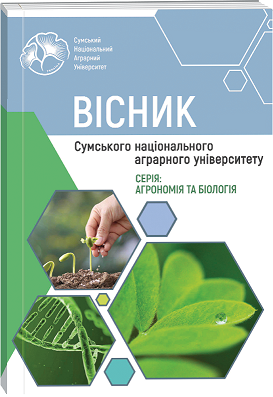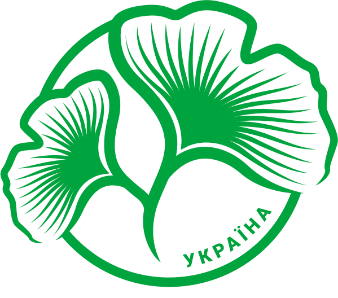RADIOECOLOGICAL ASSESSMENT OF GRAY FOREST SOIL IN NATURAL MEADOWS OF THE RIGHT-BANK FOREST-STEPPE 37 YEARS AFTER THE CHORNOBYL NPP ACCIDENT
Abstract
The technogenic load on natural forage lands increases annually due to human activity. Among pollutants, radionuclides are the most dangerous for living organisms. In an exchangeable form and migrating through natural ecosystems, radionuclides enter living organisms, causing various disruptions at cellular, organ, and organismal levels. Irradiation-related disturbances lead to a range of diseases, which result in immune system suppression. The primary pathway for radionuclides into living organisms is the food chain. Radionuclides in a soluble form from soils accumulate in plants, transferring to plant products, and eventually enter the human body through consumption. To reduce radiation exposure on the population, several measures are used to hinder radionuclide migration in the soil → plant → human system. The main ones include agrotechnical measures, in particular, soil cultivation, the use of sorbents, mineral fertilizers, specialization in the field of crop production, and others. However, these measures are less effective in natural meadows, so their vegetation must be constantly monitored. The problems of using agrotechnical measures to reduce the migration of radionuclides in the soil → vegetation system in the conditions of natural meadows are primarily due to high economic costs and the impossibility of their effective use. Natural meadows before the application of agrotechnical measures to reduce the migration of radionuclides into vegetation require additional costs for the preparation of areas for rehabilitation, moreover, the uneven terrain does not allow the effective use of agrotechnics. Monitoring for cesium-137 contamination of natural forage meadows in Vinnitsa showed that its concentration in gray forest soils does not exceed pre-Chоrnobyl accident levels, ranging from 0.105 Ki/km² to 0.247 Ki/km². Research indicates that, in the right-bank forest-steppe, cesium-137 content in gray forest soil of natural forage meadows follows this increasing order: normal drylands → absolute drylands → excessively moist drylands. The lowest cesium-137 content in gray forest soil was observed in normal drylands, while the highest was in excessively moist drylands. The greatest difference in cesium-137 content in gray forest soils from 2019 to 2024 was found in normal drylands, characterized by abundant grass-legume vegetation and active cattle grazing, while the smallest difference was observed in overly moist meadows, whose forage material is less suitable for livestock feeding. That is, the productivity of natural meadows and the intensity of use of their vegetation by animals has a significant impact on the radiological state of natural meadows. Radionuclides, being in an exchangeable form along the trophic chain, accumulate in vegetation, and as they are consumed by animals, they also accumulate in their bodies. In territories with vegetation that is not suitable for animal consumption, the removal of cesium-137 due to phytoremediation is not very effective, which is characteristic of over moistened meadows where sedge grows mainly.
References
2. Bohovin, A. V., Saiko, V. F., & Ptashnyk, M. M. (2012). Pidvyshchennia produktyvnosti luk-pasovyshchnykh uhid na osushenykh nyzynnykh torfovyshchakh Polissia [Improving the productivity of meadow-pasture lands on drained lowland peatlands of Polissya]. Zemlerobstvo, 84, 11–17 (in Ukrainian)
3. Bulyhin, S. Yu., Prister, B. S., Furdychko, O. I., & Dutov, O. I. (2012). Shchodo prohramy bezpechnoho vedennia silskohospodarskoho vyrobnytstva na terytoriiakh, zabrudnenykh radionuklidamy vnaslidok Chornobylskoi katastrofy [Regarding the program for safe agricultural production on territories contaminated with radionuclides due to the Chernobyl disaster]. Visnyk ahrarnoi nauky, 5, 53–57 (in Ukrainian).
4. Chobotko, H. M., Kuchma, M. D., Landin, V. P., Raichuk, L. A., Shvydenko, I. K., Tarariko, M. Yu., Umansky, M. S., Teteruk, O. R., Solomko, V. L., Kominar, M. F., & Liabakh, S. V. (2020). Rekomendatsii z reabilitatsii radioaktyvno zabrudnenykh zemel i vidrodzhennia ahropromyslovoho vyrobnytstva na radioaktyvno zabrudnenykh terytoriiakh [Recommendations for rehabilitating radioactively contaminated lands and restoring agro-industrial production in contaminated territories]. DIA, Kyiv (in Ukrainian).
5. Datsko O.M., Yatsenko V.M. (2024). Suchasni metody remediatsii gruntiv. Fitoremediatsiia yak kliuch do ochyshchennia gruntiv ta zberezhennia ecosystem [Modern methods of soil remediation. Phytoremediation as the key to soil cleaning and ecosystem preservation]. Ahrarni innovatsii, 25, 20–24. doi: 10.32848/agrar.innov.2024.25.3 (in Ukrainian).
6. Datsko, O. M., & Yatsenko, V. M. (2024). Suchasni metody remediiatsii gruntiv. Fytoremediiatsiia yak kliuch do ochyshchennia gruntiv ta zberezhennia ekosystem [Modern soil remediation methods. Phytoremediation as a key to soil purification and ecosystem preservation]. Ahrarni innovatsii, 25, 20–24 (in Ukrainian). doi: 10.32848/agrar.innov.2024.25.3
7. Deisan M.M. et al. (2011). Rekomendatsii po vedenniu silskohospodarskoho vyrobnytstva v umovakh radioaktyvnoho zabrudnennia pivnichnykh raioniv Zhytomyrshchyny postrazhdalykh u rezultati avarii na Chornobylskii AES na period 2011–2016 rr [Recommendations for conducting agricultural production in conditions of radioactive contamination of the northern regions of Zhytomyr region affected by the Chernobyl nuclear power plant accident for the period 2011–2016.]. Korosten: Druk, 1. S. 4–5 (in Ukrainian).
8. Drebot, O.I., Demianiuk, O.S. & Raichuk, L.A. (2022). Naukovo-metodychni zasady reabilitatsii radioaktyvno zabrudnenykh ahrolandshaftiv u konteksti Zelenoi ekonomiky [Scientific and methodological principles of rehabilitation of radioactively contaminated agricultural landscapes in the context of the Green Economy]. Visnyk ahrarnoi nauky, 100, 2 (827), 74-81. DOI: 10.31073/agrovisnyk 202202-10 (in Ukrainian).
9. Drebot, O. I., Demianiuk, O. S., & Raichuk, L. A. (2022). Naukovo-metodychni zasady reabilitatsii radioaktyvno zabrudnenykh ahrolandshaftiv u konteksti Zelenoi ekonomiky [Scientific-methodological principles of rehabilitating radioactively contaminated agrolandscapes in the context of the Green Economy]. Visnyk ahrarnoi nauky, 100 (2), 74–81 (in Ukrainian). doi: 10.31073/agrovisnyk202202-10
10. Dutov O.I. (2014). Ahroekolohichni pidkhody do minimizatsii doz oprominennia naselennia u viddalenyi period rozvytku radiolohichnoi sytuatsii pislia avarii na ChAES [Agroecological approaches to minimizing radiation doses to the population in the long-term development of the radiological situation after the Chernobyl accident]. Ekolohichni nauky. DAE, Kyiv: 1(5), 24–30 (in Ukrainian).
11. Dutov, O. I., & Abidov, S. T. (2015). Radiatsiino-ekolohichni pidkhody do ratsionalnoho vykorystannia zabrudnenykh zemel dlia vyrobnytstva bezpechnoi silskohospodarskoi produktsii [Radiation-ecological approaches to the rational use of contaminated lands for the production of safe agricultural products]. Zbalansovane pryrodokorystuvannia, 1, 89–93 (in Ukrainian).
12. Furdychko, O. I. (2016). Radioekolohichna bezpeka ahrarnykh i lisovykh ekosystem u viddalenyi period pislia avarii na ChAES [Radioecological safety of agrarian and forest ecosystems in the distant period after the Chornobyl disaster]. Ahroekolohichnyi zhurnal, 1, 6–14 (in Ukrainian).
13. Havrysh, N. S. (2016). Vykorystannia, vidtvorennia ta okhorona gruntiv v Ukraini: teoretyko-pravovi aspekty [Usage, restoration, and protection of soils in Ukraine: theoretical and legal aspects]. Yuryd. l-ra, Odessa (in Ukrainian).
14. Hryhora, I. M., & Yakubenko, B. E. (2001). Vysokotravni bolotni ta luchno-bolotysti uhrupovannia Lisostepu Ukrainy [Tall wetland and meadow-wetland groups of the forest-steppe of Ukraine]. Ahrarna nauka i osvita, 1–2, 11–21 (in Ukrainian).
15. Hrynyk O.I. (2015). Osoblyvosti funktsionalnoho vykorystannia radioaktyvno zabrudnenykh silskohospodarskykh zemel Kyivskoho Polissia [Features of the functional use of radioactively contaminated agricultural lands of Kyiv Polissya]. Ahrosvit, 15, 73–77 (in Ukrainian).
16. Hrynyk, O. I. (2015). Osoblyvosti funktsionalnoho vykorystannia radioaktyvno zabrudnenykh silskohospodarskykh zemel Kyivskoho Polissia [Features of the functional use of radioactively contaminated agricultural lands in Kyiv Polissya]. Ahorosvit, 15, 73–77. (in Ukrainian)
17. Hudkov, I. M. (2016). Radiobiolohiia: pidruchnyk [Radiobiology: textbook]. OLDI-PLYUS, Kherson (in Ukrainian).
18. Hudkov, I. M., Kashparov, V., & Paryeniuk, O. (2018). Radioekolohichnyi monitorynh: navch. рosib. [Radioecological Monitoring: teaching aid]. Kyiv, 55–65. (in Ukrainian)
19. Jeong, S.-W., & Choi, Y. J. (2017). Research Perspective of an Extremophilic Bacterium. Deinococcus radiodurans on Bioremediation of Radioactive Wastes. Applied Chemistry for Engineering, 28 (2), 133–140. doi: 10.14478/ace.2017.1003
20. Khomutinin, Yu. V., Kosarchuk, O. V., Polishchuk, S. V., Lazaryev, M. M., Levchuk, S. E., & Pavlyuchenko, V. V. (2022). Otsinka mozhlyvosti povernennia do hospodarskoho obihu vyvedenykh, vnaslidok avarii na ChAES, pasovyshch i sinozhatok [Assessment of the possibility of returning withdrawn pastures and hayfields into agricultural circulation due to the Chornobyl accident]. Yaderna fizyka ta enerhetyka, 23 (1), 47–56. doi: 10.15407/jnpae2022.01.047 (in Ukrainian)
21. Kovalenko, V. P. (2012). Bioloho-tekhnolohichni peredumovy oderzhannia vysokoiakistnykh kormiv [Biologicaltechnological prerequisites for obtaining high-quality feeds]. Kormy i kormovyrobnytstvo, 74, 41–47. (in Ukrainian)
22. Landin, V. P. (2016). Radiatsiino-ekolohichni problemy vidnovlennia silskohospodarskoho vyrobnytstva v Ukrainskomu Polissi [Radiation-ecological issues of agricultural production recovery in Ukrainian Polissya]. Ahroekolohichnyi zhurnal, 1, 88–93 (in Ukrainian).
23. Landin, V. P., Chobotko, H. M., Tarariko, M. Yu., Raichuk, L. A., & Shvydenko, I.K. (2018). Ekolohichno-ekonomichni zasady reabilitatsii radioaktyvno zabrudnenykh zemel Polissia [Ecological-economic principles for rehabilitating radioactively contaminated lands in Polissya]. Ahrarna nauka, Kyiv (in Ukrainian).
24. Lopushniak, V. I., Avhustynovych, M. B., & Bortnik, T. P. (2016). Vplyv ekolohichno bezpechnykh tekhnolohii na balans pozhyvnykh rechovyn u siromu lisovomu hrunti zakhidnoho Lisostepu Ukrainy [Impact of environmentally safe technologies on nutrient balance in gray forest soil of the western forest-steppe of Ukraine]. Visnyk Lvivskoho NAU. Ahromoniia, 20, 149–155 (in Ukrainian).
25. Makarenko, P. S. (2008). Luchne i polove kormovyrobnytstvo [Meadow and field fodder production]. V.H., Vinnytsia, FOP Danyliuk (in Ukrainian).
26. Melnyk, V. V. (2020). Osoblyvosti rozpodilu 137Cs u komponentakh lisovoho bioheotsenoza svizhykh boriv Ukrainskoho Polissia [Features of 137Cs distribution in the components of the forest biogeocenosis of fresh pine forests in Ukrainian Polissya]. Visnyk Poltavskoi derzhavnoi ahrarnoi akademii, 2, 88–98 (in Ukrainian).
27. Moisiienko V.V. & Shevchuk О.Ia. (2006). Ekolohichnyi stan, shliakhy polipshennia i produktyvnist pryrodnykh kormovykh uhid v umovakh radioaktyvnoho zabrudnennia Polissia Ukrainy [Ecological condition, ways of improvement and productivity of natural forage lands in conditions of radioactive contamination of Polissya, Ukraine]. Tem. mizhvid. nauk. zb. “Kormy i kormovyrobnytstvo”, 58, 9–196 (in Ukrainian).
28. Moosavi, S. G., & Mohamd, J. S. (2013). Phytoremediation: a review. Advance in Agriculture and Biology, 1 (1), 5–11.
29. Mudrak, O. V. (2011). Ekolohichnyi stan dovkillia Vinnytskoi oblasti: navch.-metod. posib. [Environmental status of Vinnytsia region: teaching-methodological manual]. Vinnytsia (in Ukrainian).
30. Olifirovych, V. O. (2018). Produktyvnist bahatorichnykh ahrofytotsenoziv zalezhno vid skladu travosumishok i rezhymu yikh vykorystannia [Productivity of perennial agro-phytocenoses depending on the composition of grass mixtures and their usage mode]. Visnyk ahrarnoi nauky, 3, 13–17 (in Ukrainian).
31. Omelianets, M. I., Piven, N. V., Hunko, N. V., Korotkova, N. V., & Sribna, V. D. (2014). Stan radioaktyvnoho zabrudnennia produktiv kharchuvannia ta osoblyvosti yikh spozhyvannia meshkantsiamy naibilsh radioaktyvno zabrudnenykh terytorii Ukrainy u viddalenyi period likvidatsii naslidkiv Chornobylskoi katastrofy [Radioactive contamination of food products and peculiarities of their consumption by residents of the most contaminated areas of Ukraine in the distant period after the Chernobyl disaster]. Problemy radiatsiinoi medytsyny ta radiobiolohii, 19, 126–135 (in Ukrainian).
32. Petrychenko, V. F. (2010). Aktualni problemy kormovyrobnytstva v Ukraini [Current issues of fodder production in Ukraine]. Visnyk ahrarnoi nauky, 10, 18–21 (in Ukrainian).
33. Razanov, S. F., Shevchuk, V. V., & Kominar, M. F. (2021). Vplyv obrobky hruntu na nakopychennia 137Cs u kvitkovomu pylku ta u produktakh pererobky yoho medonosnoiu bdzholoiu [Effect of soil cultivation on 137Cs accumulation in pollen and its processing products by honey bees]. Silske hospodarstvo ta lisivnytstvo, 3 (22), 161–173 (in Ukrainian). doi: 10.37128/2707-5826-2021-3-13
34. Romanchuk, L. D. (2015). Radioekolohichna otsinka formuvannia dozovoho navantazhennia u meshkantsiv silskykh terytorii Polissia Ukrainy [Radioecological assessment of dose load formation in rural residents of Polissya, Ukraine]. Polissia, Zhytomyr (in Ukrainian).
35. Romanchuk, L. D., Lopatyuk, O. V., & Kovalova, S. P. (2019). Otsinka vmistu radionuklidu 137Cs u produktakh kharchuvannia meshkantsiv radioaktyvno zabrudnenykh terytorii u viddalenyi period pislia avarii na ChAES [Assessment of 137Cs content in food products consumed by residents of radioactively contaminated areas in the distant period after the Chornobyl accident]. Naukovi horyzonty, 8 (81), 82–86. (in Ukrainian). doi: 10.33249/2663-2144-2019-81-8-82-86
36. Singh, B. S. M., Singh, D., & Dhal, N. K. (2022). Enhanced phytoremediation strategy for sustainable management of heavy metals and radionuclides. Case Studies in Chemical and Environmental Engineering, 5, 100–176. doi: 10.1016/j.cscee.2021.100176
37. Vedennia silskohospodarskoho vyrobnytstva na terytoriiakh, zabrudnenykh vnaslidok Chornobylskoi katastrofy, u viddalenyi period [Conducting agricultural production in the territories contaminated as a result of the Chernobyl disaster in the long term]. navch. vyd. za red. akad. UAAN B. S. Pristera (2007). Kyiv: TOV VPF «MEHA» (in Ukrainian).
38. Vedennia silskohospodarskoho vyrobnytstva na terytoriiakh, zabrudnenykh vnaslidok Chornobylskoi avarii, u viddalenyi period [Conducting agricultural production in the territories contaminated as a result of the Chernobyl accident in the long term]: Metodychni rekomendatsii. Za zah. red. akad. B.S. Pristera (2007). Atika-N (in Ukrainian).

 ISSN
ISSN  ISSN
ISSN 



